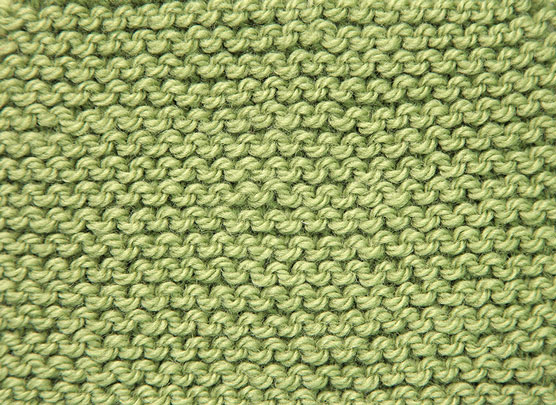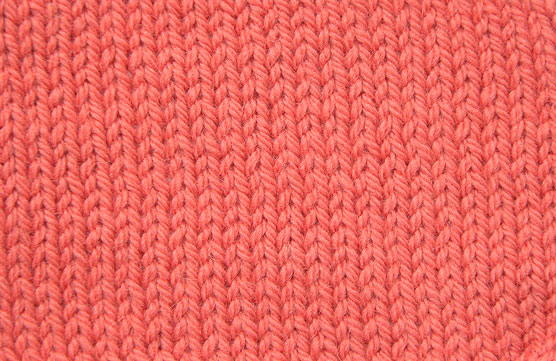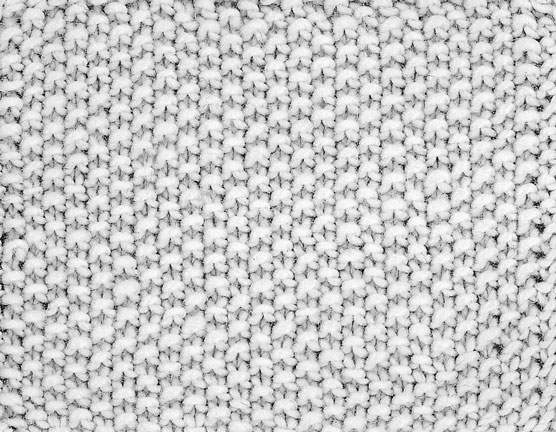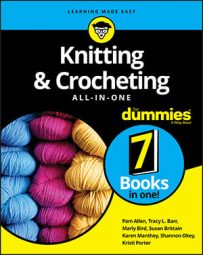Another stitch all knitters should have in their repertoire is seed stitch. Although a little more complicated than garter and stockinette stitches, seed stitches create an interesting texture and appear in many patterns.
Knits and purls have a quirky but predictable relationship to each other. When lined up horizontally, the purled rows stand out from the knitted rows. Arranged in vertical patterns, like ribbing, the purl stitches recede and the knit stitches come forward, creating an elastic fabric.
When worked in a balanced manner (meaning the same number of knits and purls appear on each side of the fabric), as in seed stitch and its variations, the fabric is stable — it lies flat and doesn’t have the tendency to roll in on the edges. These qualities make seed and moss stitches, as well as garter stitches, good choices for borders that need to lie flat and not pull in as ribbed borders do.
Garter stitch
Garter stitch is the most basic of all knitted fabrics. It’s made by knitting every row. (You can create garter stitch by purling every row, too. Neat, huh?) You can recognize garter stitch by the horizontal ridges formed by the tops of the knitted loops on every other row. Garter stitch
Garter stitchGarter stitch has a lot going for it in addition to being easy to create. It’s reversible, lies flat, and has a pleasant rustic look. Unlike most knitted fabrics, garter stitch has a square gauge, meaning that there are usually twice as many rows as stitches in 1 inch. To count rows in garter stitch, count the ridges and multiply by two, or count the ridges by twos.
Garter stitch has a hanging gauge that stretches more vertically. Therefore, gravity and the weight of the garter stitch piece pulls on the fabric and actually makes it longer. This is important to keep in mind when you’re making a garment that you want to fit properly and not grow two times larger after an hour of wearing it.
Stockinette stitch
When you alternate a knit row with a purl row (knit the first row, purl the second, knit the third, purl the fourth, and so on), you create stockinette stitch. You see stockinette stitch everywhere: in scarves, socks, sweaters, blankets, hats — you name it. In fact, most beginning and intermediate designs incorporate stockinette stitch. Stockinette stitch showing the knit side
Stockinette stitch showing the knit sideIn written knitting instructions, stockinette stitch (abbreviated St st) appears like this:
Row 1 (RS): Knit.Stockinette fabric looks and behaves in a particular way. To successfully incorporate this stitch into your knitting repertoire, pay attention to the following:Row 2 (WS): Purl.
Rep Rows 1 and 2 for desired length.
- Stockinette stitch has a right side and a wrong side (though, of course, either side may be the “right” side, depending on the intended design). The right side is typically the smooth side, called stockinette or On this side, the stitches look like small Vs. The bumpy side of stockinette stitch fabric is called reverse stockinette or purl.
If you’re working in stockinette stitch and you lose track of whether you knit the last row or purled it, not to worry. You can tell what to do next by looking at your knitting. Hold your needles in the ready-to-knit position (with the LH needle holding the stitches to be worked) and look at what’s facing you. If you’re looking at the knit (smooth) side, you knit. If you’re looking at the purl (bumpy) side, you purl. A good mantra to say to yourself is knit the knits and purl the purls.
- Stockinette fabric curls on the edges. The top and bottom (horizontal) edges curl toward the front or smooth side. The side (vertical) edges roll toward the bumpy side. Sweater designers frequently use this rolling feature deliberately to create rolled hems or cuffs, and you can create easy cords or straps simply by knitting a very narrow band in stockinette stitch (say, four or six stitches across).
But when you want the piece to lie flat, you need to counteract this tendency by working the three or four stitches on the edge in some stitch that lies flat (like garter stitch, discussed in the preceding section, or seed stitch, discussed in the next section).
To figure out the gauge of a swatch knitted in stockinette stitch, count the Vs on the smooth side or right side. They’re easier to see and distinguish than the bumps on the wrong side. Of course, if you find the bumps easier to count, it’s okay to do so.The names garter stitch and stockinette stitch date from the 1500s, when hand-knit stockings were a major industry in England. Garter stitch was used at the top of the stocking, where it needed to expand for the thigh, and stockinette (or stocking stitch) was used for the fitted leg portion.
Seed stitch
Seed stitch, shown in the figure below (and demonstrated in the video below), consists of single knits and purls alternating horizontally and vertically. Its name refers to the way the knitted fabric looks: The little purl bumps look like scattered seeds. Like garter stitch, seed stitch lies flat, making it a good edging for a sweater border and cuffs. It also looks the same from both sides, making it a nice choice for scarves and other pieces of which both sides are visible. Seed stitch
Seed stitchSeed stitch stitch gauge tends to be wider than a stockinette stitch stitch gauge. This is important to note if you plan to mix stitch patterns but want to maintain the same measurements in both patterns.
Unfortunately for novice knitters, who often forget to move the yarn accordingly, instructions don’t explicitly tell you to bring your yarn to the front or back of your work. They assume that you know where the yarn should be when you’re about to knit or purl a stitch. As you practice the patterns that combine both knit and purl stitches, make sure your yarn is in the proper position for each stitch before you start it.
To create seed stitch:
Cast on an even number of sts.When working seed stitch, you alternate between knit and purl stitches in each row. The trick to creating the little “seeds” is to knit in the purl stitches of the previous row and purl in the knit stitches of the previous row.Row 1: * K1, p1; rep from * to end of row.
Row 2: * P1, k1; rep from * to end of row.
Rep Rows 1 and 2 for pattern.
If you’re working in seed stitch and you lose track of whether you knit the last stitch or purled it, don’t worry. You can tell what to do next by looking at your knitting. Hold your needles in the ready-to-knit position (with the LH needle holding the stitches to be worked or the ones you’re working on) and look at what’s facing you.
On the LH needle, if you’re looking at a knit stitch, you purl. If you’re looking at a purl (bumpy) stitch, you knit. A good mantra to say to yourself is knit the purls and purl the knits.

